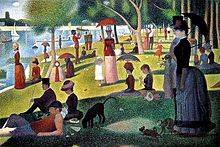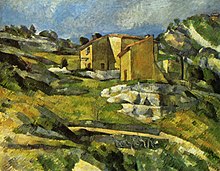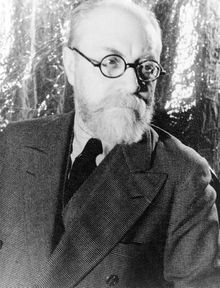Henri Matisse
![]()
This article is about the French painter. For the variety of rose named after him, see Henri Matisse (rose).
Henri Matisse [ɑ̃ʁi matis], full name: Henri Émile Benoît Matisse (born 31 December 1869 in Le Cateau-Cambrésis, Nord département, France; † 3 November 1954 in Cimiez, now a district of Nice), was a French painter, graphic artist, draughtsman and sculptor.
Together with Pablo Picasso, he is one of the most important artists of Classical Modernism. Along with André Derain, he is considered a pioneer and main representative of Fauvism, which propagated the separation from Impressionism and represents the first artistic movement of the 20th century.
Matisse's work is carried by an extensive use of colour and tension-filled lines. In his paintings, the colouring, the playful composition and the lightness of his pictorial themes are the result of long studies.
With his silhouettes (gouaches découpées) created in the 1940s - one example is the artist's book Jazz - Matisse, who was seriously ill, created a late work that brings his efforts at reduction to a conclusion and, with its colorfulness and ornamentation, is considered the high point of his artistic career. The artist considered the Chapel of the Rosary in Vence, which he planned and decorated, inaugurated in 1951, to be his masterpiece.
His stylistic innovations influenced modern art. Thus the abstract expressionists in the USA repeatedly referred to his work.
The pictorial work
"The teachers at the Beaux-Arts used to say, 'Stick stubbornly to nature!' Throughout my career I rebelled against this attitude, to which I could not submit. This confrontation resulted in various turns in my path, which was a constant search for expression beyond the naturalistic copy; such turns were Divisionism and Fauvism, for example."
- Henri Matisse, 1951
Matisse's conception of the image
In Matisse's pictorial world, colour acquires an autonomous character through its two-dimensional, decorative and ornamental use, omitting its spatial design aspects. Here, the use of color is neither subordinated to local color nor to the description of surface structures. Rather, Matisse uses it as a means of reproducing the color sensations triggered in the painter by the impression of the motif. On his way through Fauvism, he created a pictorial world in which no more importance is attached to the object than to the interior space, that is, the space between the objects. None of these forms is superior or subordinate to another in the realization of 'expression' as a design element. According to this view, 'expression' can only be realized through the arrangement and connection of the color forms - color and form are one - among each other. Through this point of view, the observation of nature (object) not only becomes the occasion for colorful sensations (subject), but in their reciprocal interaction is also elevated to a corrective within the creative process. In this sense Matisse saw himself connected to tradition. Thus Matisse - like Picasso - never took the step towards complete abstraction, since in this way, as he emphasized, abstraction was only imitated.
Another characteristic of Matisse's pictorial composition is that he linearizes the objects. The spatial relationships between the objects recede into the background, are dissolved, but without completely negating their spatial references. Thus he emphasized that the equality of forms - object and interior space - as well as the autonomy of color necessitated a linearization of the pictorial elements, and vice versa.
The growing need for originality and individuality in those days, on the one hand, and the aversion to what their opponents saw as the "degenerate" views of the still-established academies, on the other, led many painters to want to take their own position. Thus, although Matisse found in Cézanne the figure of the spiritus rector, he did not intend to continue Cézanne's work.
The early work until 1900
Matisse decided late in life to pursue an artistic career. As a 20-year-old paralegal in St.-Quentin, he began to take art lessons. His first paintings corresponded to the bourgeois naturalism that the French school had adopted from the Dutch. A well-known painting from this period is The Reader from 1894, now in the Musée National d'Art Moderne in Paris. In his pictorial subjects, women will dominate his art from his early work to his late work in the 1950s, depicted in Matisse's various phases. Still Life with Self-Portrait in similar brown-green colors followed in 1895, bearing a resemblance in aesthetic to Cézanne's still life twenty years his senior without its sophistication. Well-known paintings from 1897 include The Table Set and the seascape, Belle Île; in the latter there are approximations to Claude Monet's 1896 Storm in Belle Île, reflecting the Impressionist influences of Monet and John Peter Russell in Brittany.
The artist's main work can be divided into the following five periods:
Fauve period (1900-1908)
→ Main article: Fauvism
In 1900, Matisse began to paint in a style that has been called "proto-fauve". He did not want to see his forms dissolved in light, but rather conceived as a complete whole, and so he moved away from "orthodox" Impressionism. It was Seurat's Divisionist works, along with those of Paul Cézanne, to which he devoted his attention. Georges Seurat and the Neo-Impressionists created their works according to the theoretical doctrine based on Eugène Chevreul's color theory. In addition to Seurat, it was Vincent van Gogh and Paul Gauguin who heightened Matisse's sense of color; he wanted to overcome the imitation of nature. Matisse's figure composition Luxury, Silence and Desire (1904/05), for example, was created according to Divisionist rules. A little later, he realized that the Divisionist conception of the picture was not suited to give the pictorial works solidity and to reflect the painter's color sensations, so he turned away from the Impressionist direction, as Cézanne had done years before him.
The result of his work during his Fauvist phase represented a solution in the form of flat colouring, which countered the "melting away" of Impressionist paintings. Examples include Open Window in Collioure and Woman with Hat, both from 1905, which provoked outrage at the Salon exhibition and thus led to the term "Fauvism". In his painting The Green Stripe. Portrait of Madame Matisse, also from 1905, green forms a permanent feature. The stripe above the face, which at first glance seems unnatural, is not placed arbitrarily, but serves as a boundary between the light and shadow zones. Matisse showed that the autonomy of color in conjunction with its two-dimensional application meant that the objects were to be linearized among themselves, their spatial relationships thus having to recede into the background. The works of the following years primarily represent variations on this fundamental insight.
According to his own statement, his life's work began with the painting The Joy of Living, which he exhibited in 1906 at the Salon des Indépendants, where it provoked fierce criticism. After the 1906 trip to Algeria, he painted Blue Nude (Memory of Biskra), the palm trees in the background reflecting the trip. The female nude weighs heavily on the ground and casts a shadow. The dominant figure and the flat surroundings reflect Matisse's view: "It is precisely the figure and not the still life or the landscape that interests me most. It is in her that I can best express, one might say, the religious feeling towards life that is always mine."
Experimental Period (1908-1917)
"The paintings of the Impressionists are full of contradictory impressions. We want something different, we want to achieve inner balance through simplification of ideas and shaping forms."
- Henri Matisse, 1909
Matisse's experimental period, during which he was very productive, is divided into two phases: From 1908 to 1910, organic fluid and arabesque forms predominate, while the second phase from 1911 to 1917, marked by Matisse's involvement with Cubism, is dominated by geometric forms. Matisse never subordinated his painting to a uniform style, but he frequently changed positions, from decorative to more realistic periods.
In 1909, the Russian art patron Sergei Ivanovich Shchukin commissioned two large works, La Danse (The Dance) and La Musique (The Music), to decorate the staircase of his Moscow residence. Two versions of the Dance were created in different shades of colour. Matisse was inspired by the Provençal round dance Farandole. The pictures, each consisting of five bodies in front of a strongly coloured background, convey joie de vivre; the decorative style combines with the human figure. Their monumentality follows from the simplification of the painterly means: few colours are applied in large homogeneous areas, the drawing becomes a pure line forming the forms. Dance is one of Matisse's most famous works. The simplification of forms also defines the painting Bouquet of Flowers and Ceramic Plate (1911). Henri Matisse summarized his impressions of Russian icons as well as objects made of enamel in an interview for the newspaper Utro Rossii (Утро России) on October 27, 1911, during his stay in Moscow:
"This is the true primitive, this is authentic folk art. This is the primal source of the artistic quest. Today's artist should find his inspiration here, in these objects of primitive art."
During the First World War his colour scale became darker, the reduction to geometric forms in the style of Cubism reached its climax in 1914 with the picture View of Notre Dame and continued until 1918. The color black played a major role during the war years, one example being the door window in Collioure, 1914.
Nice Period (1917-1929)
Matisse devoted himself, among other things, to painting odalisques in various positions. Portraits, light-flooded interiors, still lifes, landscapes were also at the center of his representational interest. His works showed more naturalistic traits than ever before. By making his imaginative vision real, Matisse demonstrated his belief in painting as a "source of unalloyed joy".
The love of color and detail is evident in the often extraordinary "ornamental background". The painting Decorative Figure against an Ornamental Background (1925/26) particularly features the emblematic attributes of his painting: a woman, flowers and colorful fabrics in the background. It is one of the most important works of the "Nice Period". His model at this time was Henriette Darricarrère. In Nice, he decorated his studio with panels of fabric, carpets and curtains. The fabric covered with flowers appears in other works, for example in Two Odalisques (1927/28) and Odalisque with Armchair (1928).
Period of renewed simplicity (1929-1940)
The Nice period was followed by a period of renewed simplicity. Matisse's artistic aspirations focused on the harmony between the maximum development of color and a progressive abstraction of representational form.
In 1929, he traveled to the United States and served as a judge for the 29th Carnegie International. A year later he traveled to Tahiti, New York, and Baltimore, Maryland, as well as Merion, Pennsylvania. Albert C. Barnes of Merion, a major modern art collector who already owned the largest Matisse collection in America, commissioned the artist to create a large mural for the art gallery of his home. Matisse chose a dance theme that had occupied him since his Fauvist phase. The mural The Dance exists in two versions due to an error in the measurements; it was installed in May 1933 and is currently on display at the Barnes Foundation. In its simplicity, the composition depicts dancing women in exaggerated motion against an abstract, almost geometric background. In preparing the mural, Matisse employed a new process, assembling the composition from cut-out pieces of colored paper. From 1940 onwards, silhouettes became Matisse's preferred means of expression, a technique he retained until the end of his life.
Period of restriction to the essentials (1940-1954)
The reduction of form to abstraction led Matisse to emphasize the dynamic element. Around 1943, due to his serious illness, silhouettes became a main means of expression in the artist's work; around 1948, Matisse stopped painting altogether. He had assistants paint sheets of paper with monochrome gouache paint, from which he cut out his figures and free forms (gouaches découpées). Matisse called this technique "drawing with scissors." It offered the possibility of combining line and colour, and was therefore the solution he had long sought to his problem. In drawing, he was able to represent an impression in a few outlines, albeit without color. In painting this spontaneity was lacking. When the scissors replace the brush and draw directly into the paint, the opposition of color and line is overcome. The result - the cut - is sharper than the drawn line, so it has a different character. In 1947, a sequence of silhouettes from the years 1943 to 1944 was published as an artist's book under the title Jazz, which had been reproduced using stencil printing. The title alludes to the spontaneity and improvisation of the musical style of jazz. On the use of lines, Matisse wrote in this book:
"The plumb line determines the vertical direction and, together with its counterpart, the horizontal, forms the draughtsman's compass. [...] The 'arabesque' develops around this assumed line. I derived lasting benefit from the use of the plumb line. The vertical is drawn in my mind, it helps me to determine the direction of my lines precisely, and even in my quickly thrown down drawings no line [...] has been created without a relation to the vertical. - My lines are not crazy."
- Henri Matisse
In addition, there were designs for tapestries such as Polynesia - The Sky and Polynesia - The Sea, 1946. The decoration of a chapel, the Rosary Chapel, (also called Chapelle Matisse), in Vence, inaugurated in 1951, whose stained glass windows he had also prepared in silhouettes, shows the artist's first stained glass. Another example is the series Blue Nude from 1952; it is exclusively in blue and white and has a sculptural effect in its abstraction.

Georges Seurat: A Sunday Afternoon on the Island of La Grande Jatte, 1884-1886

Paul Cézanne: House in Provence, 1882-1885
The graphic work - book illustrations
Matisse created drawings, studies for his works, in large numbers. His interest in graphic works began around 1900, when he began etching on a trial basis. The catalogue raisonné of his prints, edited by his daughter Marguerite Duthuit and his grandson Claude Duthuit, describes some 800 works, focusing on the approximately 300 etchings and 300 lithographs produced between 1908 and 1948, from 1906 to 1952. In addition, he created 62 works in aquatint, 68 monotypes, 70 linocuts and, from the early period 1906/07, four woodcuts. Unlike Picasso, Matisse refrained from experimenting with new materials and techniques. In 1935 Matisse produced 26 full-page illustrations for the novel Ulysses by James Joyce. The illustrations are based on themes from Homer's Odyssey.
After the outbreak of the Second World War, Matisse's graphic work took up a larger space, with illustrations for Henry de Montherlant's Pasiphaé (1944), Pierre Reverdy's Visages (1946), Mariana Alcaforado's Lettres portugaises (1946), Charles Baudelaire's Les Fleurs du Mal (1947), Pierre de Ronsard's Florilège des Amours (1948), and Charles d'Orléans's Poèmes (1950). These books usually featured black-and-white illustrations; in contrast, he provided his well-known 1947 artist's book Jazz, in which he wrote down his reflections on art and life, with color illustrations.
Questions and Answers
Q: Who was Henri Matisse?
A: Henri Matisse was a French artist known for his use of colour and his original ideas. He was mainly known as a painter, but he was also a draughtsman, printmaker and sculptor.
Q: What type of art did Matisse create?
A: Matisse created brilliantly coloured canvases structured by colour applied in a variety of brushwork, ranging from thick impasto to flat areas of pure pigment, sometimes accompanied by a sinuous, arabesque-like line.
Q: What is Fauvism?
A: Fauvism is the first avant-garde movement (1905–7) which used arbitrary combinations of bright colors and energetic brushwork to structure the composition. It is named "Fauvism" by a contemporary art critic referring to its wild beast like nature.
Q: What kind of subjects did Matisse paint?
A: Although he was initially called a Fauve (wild beast), he painted many traditional themes such as portraits and other figurative subjects.
Q: How long did Matisse's career span?
A: Matisse's career spanned over half a century.
Q: Where did Matisse die?
A:Matisse died of a heart attack in Nice, Alpes-Maritimes.
Q: How has Matisse been recognized for his work?
A:Matisse has been recognized as one of the leading figures in modern art due to his mastery of the expressive language of form and colour throughout his career.
Search within the encyclopedia
